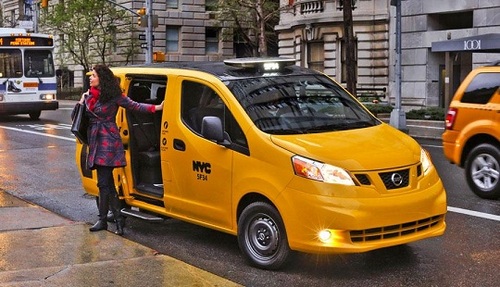John Heilig Reviews The New NYC Nissan NV200 Taxi
 2014 Nissan NY Taxi NV200 |
THE AUTO PAGE
By John Heilig
Reviewed Model: 2014 Nissan NV200 NYC Taxi
Metrics
Engine: 2.0-liter I4
Horsepower/Torque: 131 hp @ 5,200 rpm/139 lb.-ft. @ 4,800 rpm
Transmission: Xtronic CVT
Wheelbase: 115.2 in.
Length x Width x Height: 186.3 x 68.1 x 73.7 in.
Tires: P185/60R15
Economy: 24 mpg city/26 mpg highway/17.8 mpg test
Fuel capacity: 14.5 gal.
Curb Weight: 3,260 lbs.
Sticker: About $30,000
The Bottom Line: The future New York City (and other cities) taxi cab, the Nissan NV200, has its good points, and some missed opportunities. As a driver, it’s so-so; as a rider, it does the job well.
When I heard about the new Official New York City taxi, I knew I had to drive one. Then, when Nissan took a bunch of New York-area journalists to Washington for the DC Auto Show, we were picked up at the train station in a fleet of Nissan NV200 taxis, in New York City livery.
We packed four adults in the cab (three in the back and one in the “shotgun” seat), and were all fairly comfortable. In addition, we got our luggage in the cargo area with no problems. So, first out, as a taxi, the Nissan does its job well.
Like all NYC taxis, this one is painted bright yellow. We had the standard roof sign to indicate the cab’s number and whether or not it was in use. By the time I got the tester, the “Vacant” lights on the rear uprights had been disconnected because they were causing too much confusion for pedestrians. What wasn’t disconnected was a light indication that passengers might be disembarking whenever the sliding side doors were opened. That was a nice feature.
The three rear seats are a bench. The front passenger seat is upholstered in the same leather-like fabric. The driver’s seat, however, is upholstered in cloth. The two are separated by a console.
Rear passengers are separated from the driver by a thick, bullet-proof, plastic divider. There is a credit card receptacle if you choose to pay the driver that way, and a small opening behind the front passenger’s headrest if you want to pay by cash. There’s also an intercom to communicate between the front and rear seats.
What I found interesting was that there is excellent driver protection for the driver from the rear passengers, but the one in the shotgun seat could actually be carrying a shotgun to hold up the driver if he/she wanted.
That divider, and the B-pillar created an enormous blind spot to the right side for the driver. However, to be fair, a trip to NYC during the week I had the taxi (no, I didn‘t drive it in) revealed similar blind spots in the Ford Crown Victoria, Toyota Prius and minivans currently in use as taxis in the city.
Nissan has installed large rectangular mirrors with a convex mirror in the top outside corner to provide visibility for the driver. Of course, we all know NYC cabbies don’t care if there’s anyone there; they just go.
The driver faces a simple instrument panel with a large center-mounted speedometer and a smaller tachometer. There are basic HVAC controls and a navigation screen to find out-of-the-way locations. In addition, there is the intercom switch and rear air conditioner and light switches. The driver also has USB and AUX hookups. The driver’s seat has an arm rest, while the shotgun has to ride armrest-less. While our tester had a backup camera, it was dim in all lighting, so essentially useless.
The rear is the true test of a taxi, with excellent leg and headroom. As I said earlier, there was also adequate shoulder room for three adults in winter clothing. There’s a large screen in the rear for those annoying ads they run. Rear passengers also get a pair of USB connections and a 12-volt outlet. Cup holders in the sliding doors are a good design.
Entrance to the rear is facilitated by a small step that moves out when you open the rear door. This step can hit high curbs if you drive too close to them. There are grab handles on the B-pillars to facilitate entry as well.
I was disappointed in the economy, and if I was in the market for a cab, I’d want something more. I think Nissan could have used a hybrid set-up, especially for a vehicle that will be driven in a city environment almost 100 percent of the time. Start/stop technology, where the engine shuts off at stop lights, would also improve economy. It could also be electric-powered, a la the Leaf, and the driver could return it to the garage for a re-charge or even a different vehicle when power runs low.
But from where most people will experience the Nissan Taxi, it does its job well. Passengers will ride in comfort and will enter and exit the taxi relatively easily.
© 2014 The Auto Page


